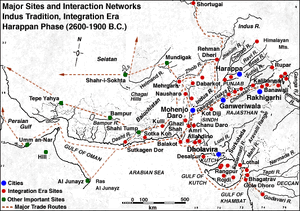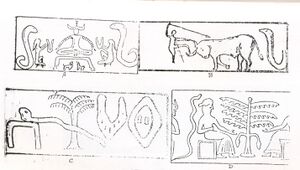Chanhudaro
| Author:Laxman Burdak, IFS (R) |

Chanhudaro (चान्हूदड़ो) is an archaeological site belonging to the post-urban Jhukar phase of Indus Valley Civilization in Nawabshah District (now called Benazirabad) Sindh province, Pakistan.
Variants
- Chanhu Daro
- Chanu Daro
- Chanudaro
- Chandaharo (चंडहारो) (पंजाब) (AS, p.314)
Location
The site is located 130 kms south of Mohenjo-daro, in Nawabshah District of Sindh, Pakistan.
Site of Indus Valley Civilization
The settlement was inhabited between 4000 and 1700 BCE, and is considered to have been a centre for manufacturing carnelian beads. This site is a group of three low mounds that excavations has shown were parts of a single settlement, approximately 5 hectares in size.
Chanhudaro was first excavated by N. G. Majumdar in March, 1930 and again during winter field session of 1935-36 by the American School of Indic and Iranian Studies and the Museum of Fine Arts, Boston team led by Ernest John Henry Mackay. Prof. W. Norman Brown of the University of Pennsylvania was instrumental in enabling the funds for this project.[1] After the independence of Pakistan, Mohammed Rafique Mughal also did exploratory work in the area.
Chanhudaro is one of the most important sites of Indus Civilization. More than 2500 sites belonging to Indus Civilization are identified so far and Chanhudaro is one of the bigger sites where lot of scope is identified for excavation. However, of late, excavations in this site have not been in progress leading to a decline in contributions from this site. It is situated in a desert area, but it is believed that the Sarasvati River used to flow near this site. Sarasvati river is believed to have dried up during 2nd millennium BC,[2] causing the life at Chanhudaro and several hundreds of dwellings situated on the banks of Sarasvati to become very difficult. The people there probably had to abandon their dwelling places and it is thought that drying up of Sarasvati is one of the reasons for the decline of these dwellings, (cities and villages) which in turn contributed to the decline of Indus Civilization itself.[3]
Chanhudaro is about 12 miles east of present-day Indus river bed. Chanhu-Daro was investigated in 1931 by the Indian archaeologist N. G. Majumdar. It was observed that this ancient city was very similar to Harappa and Mohenjadaro in several aspects like town planning, building layout etc.[4]
The site was excavated in the mid-1930s by the American School of Indic and Iranian Studies and the Boston Museum of Fine Arts, where several important details of this ancient city was investigated.[5]
Town planning - For building houses, baked bricks were used extensively at Chanhudaro and Mohenjo-daro.[5] Several constructions were identified as workshops or industrial quarters and some of the buildings of Chanhudaro might have been warehouses.[6] Industrial activity
Evidence of shell working was found at Chanhudaro and bangles and ladles were made at this site.[7] Harappan seals were made generally in bigger towns like Harappa, Mohenjadaro and Chanhudaro which were involved with administrative network.[8]
Artifacts found: Copper knives, spears, razors, tools,[9] axes, vessels and dishes were found, causing this site to be nicknamed the "Sheffield of India" by Earnest Mackay.[10] Copper fish hooks were also recovered from this site. Terracotta cart models, a small terracotta bird which when blown acts as a whistle, plates and dishes were found. Male spear thrower or dancer - a broken statue (4.1 cm) is of much importance, found at Chanhudaro, is now displayed at Museum of Fine Arts, Boston, USA.[11][12] Indus Seals are also found at Chanhudaro and Chanhudaro is considered as one of the centres where seals were manufactured.[13] The scale of craft production at Chanhudaro seems much greater than that at Mohenjodaro, perhaps taking up half of town for this activity.[14]
An Impressive workshop, recognised as Bead Making Factory, was found at Chanhudaro, which included a furnace.[15] Shell bangles, beads of many materials, stealite seals and metal works were manufactured at Chanhudaro.[16]
Cultivation: Sesame, which is a native of South Africa, is known from number of Harappan sites, including Chanhudaro, probably grown for oil.[17] Peas are also grown at Chanhudaro.[18]
In respect of Indus Script, ||/ sign is only found on inscriptions found at Chanhudaro. It occurred on eleven objects, (around one sixth of all inscribed objectes recovered from Chanhudaro) leading to suggestion by Asko Parapola that it may represent town's name.[19]
Cotton cloth traces preserved on silver or bronze objects were known from Chanhudaro, Harappa and Rakhigarhi.[20]
Objects of Iron were reported from Chanhudaro, Ahar, Rajasthan (India) and Mundigak and this gains importance as it has been claimed that Iron was produced in 3rd Millennium in South Asia Region.[21]
The Harappan Civilization and cult of Naga Worship

Dr Naval Viyogi[22]writes that The Indus Valley Civilization which is the most ancient civilization of India, was spread up in North-West: Harappa, Mohenjodaro , Chanhudaro and Lothal were its most important towns. The founders of Indus valley civilization were Mediterraneans or Dravidians and Australoids, [23] where as, round headed Alpines, appeared, in mature age of this culture. [24] In excavation of these towns, in addition to Burnished Red ware, a very high number of seals and seal impressions have also been found out. Among the seals so found out on one seal, there is a figure of chief deity with buffalo head, on its both sides, are two other man deities and behind each of them is a serpent in standing posture (See Illustration - Seal A). On another seal, there is a serpent, in standing posture, behind the bull, which is fighting with a mighty man (See Illustration - Seal B). [25] On another third seal, there is a serpent resting his head on a Wooden bench or seat, which is protecting a tree deity (See Illustration - Seal C). [26]
The presence of serpents on all the above three seals, establishes that the Naga (serpent) was their (Harappans) protector deity and symbol of authority of rule. We can draw the following conclusion from the above detail:
- The tradition of serpent worship or totemisim was prevalent in Indus Valley Civilization
- The scene depicted on the seal no.-2 (See Illustration - Seal B), shows its relation with the myths of Bobylonia, which proves origin of this tradition on Western Asia.
This fact finding is further corroborated by seal, No.4 (See Illustration - Seal D) This figure is incised on a cylinder seal recovered form Babylonia (Lajards culte de Mithra). This proves the origin of tradition of tree and serpent worship in Babylonia, from where later on it was transferred to Indus Valley. [27]
External links
References
- ↑ Possehl, Gregory L. (2004). The Indus Civilization: A contemporary perspective, New Delhi: Vistaar Publications, ISBN 81-7829-291-2, p.74.
- ↑ The Lost River by Michel Danino, Penguin India 2010
- ↑ The Lost River by Michel Danino. Penguin 2010
- ↑ Possehl, Gregory L. (2004). The Indus Civilization: A contemporary perspective, New Delhi: Vistaar Publications
- ↑ McIntosh, Jane.(2008) The Ancient Indus Valley: New Perspectives. ABC-CLIO. Page 210
- ↑ McIntosh, Jane.(2008) The Ancient Indus Valley: New Perspectives. ABC-CLIO. Page 229
- ↑ McIntosh, Jane.(2008) The Ancient Indus Valley, New Perspectives. ABC-CLIO.
- ↑ McIntosh, Jane.(2008) The Ancient Indus Valley, New Perspectives. ABC-CLIO Page 264
- ↑ [Paul Yule, A Harappan 'Snarling Iron' from Chanhu daro, Antiquity 62, 1988, 116–118, ISSN 0003-598x. URL: http://archiv.ub.uni-heidelberg.de/savifadok/volltexte/2008/145/]
- ↑ Illustrated London News, November 21, 1936
- ↑ Museum of Fine Arts, Boston
- ↑ McIntosh, Jane.(2008) The Ancient Indus Valley: New Perspectives. ABC-CLIO. Page 281
- ↑ McIntosh, Jane. (2008) The Ancient Indus Valle: New Perspectives. ABC-CLIO.Page 264
- ↑ McIntosh, Jane.(2008) The Ancient Indus Valley: New Perspectives. ABC-CLIO. Page 303
- ↑ McIntosh, Jane.(2008) The Ancient Indus Valley: New Perspectives. ABC-CLIO. Page 237
- ↑ McIntosh, Jane.(2008) The Ancient Indus Valley: New Perspectives. ABC-CLIO. Page 150
- ↑ McIntosh, Jane.(2008) The Ancient Indus Valley, New Perspectives. ABC-CLIO. Page 114
- ↑ McIntosh, Jane.(2008) The Ancient Indus Valley, New Perspectives. ABC-CLIO
- ↑ Asko Parpola (1994)
- ↑ McIntosh, Jane.(2008) The Ancient Indus Valley: New Perspectives. ABC-CLIO. Page 333
- ↑ McIntosh, Jane.(2008) The Ancient Indus Valley: New Perspectives. ABC-CLIO. Page 320
- ↑ Dr Naval Viyogi: Nagas – The Ancient Rulers of India, P.227
- ↑ Whealer R.E.M., “A.I.” Vol III Bulletin of Archaeological Survey of India (January,1947); Bose N.K. and others “Human Skeleton from Harappa” ASIC (1963) pp.58-59
- ↑ Sarkar S.S., “Aboriginal Races of India”, pp.143-45
- ↑ Sastri Kedarnath, New lights on the Indus Civilization” Vol I p.35
- ↑ Dr Naval Viyogi: Nagas the Ancient Rulers of India, p.228
- ↑ Dr Naval Viyogi: Nagas the Ancient Rulers of India, p.229

